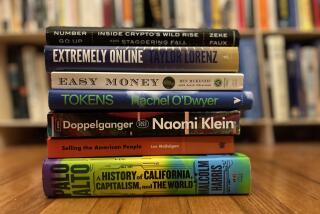Can’t Curl Up With a Cyber Book? Think Again
- Share via
“The Angels of Russia” probably would make a good film. After a sluggish start, the plot picks up to blend love, mystery and the terrors of the KGB in the ‘90s. But will anyone in Hollywood read it?
“That’s where the whole process breaks down--at the consumer end,” says London’s University College literature professor John Sutherland, who has championed the work. He chose to read “Angels” and two other virtual books while sitting at his home computer--and even though he is an “Angels” fan, he acknowledges that the experience “was not comfortable.”
He could have used the Adobe format to print the book on paper. It delivers pages like those in an expensive book, with wide margins, attractive type, plus all the extras (such as cover and dedication pages). That experience might be quite pleasant--if “Angels’ ” 400 unbound pages weren’t toppled by kids, wafted by winds, or pawed and peed on by pets.
Many readers of virtual books now prefer to use the PalmPilot, by 3Com, marketed as a personal organizer in ’96 and quickly adapted by techies as a way to read books on the run. But the visual and tactile comforts of an old-fashioned book are missing with this small-screen device, and manufacturers recognize the need for something bigger and better. A new breed of devices, from about $300 to $1,600, will hit stores next month--many destined to become Edsels.
Writer Steve Silberman tried them out for a critique in the July issue of Wired magazine, approaching the project with the skepticism of an old-fashioned bibliophile. He found them too heavy, too clumsy, too poorly lit for reading his favorite novels--until he found one he adored. Whereupon he waxed lyrical:
“I find myself wanting to be alone with the Rocketbook, to slip out the door and click through its pages under the night sky. . . . It’s like an object that has tumbled out of the future.”
*
Ah, but even this object of his ecstasy soon may be eclipsed. The New Media Lab at MIT is at work on “The Last Great Book,” an item that may make moot all future reading debate.
It will look like, feel like and read like an old-fashioned book. Its pages will be paper, and it will be shaped and bound in the best classic mode. The pages will remain blank until you push one of the buttons on the spine to select the book you want to read.
At that point, new electronic ink (called “E-ink”) will print the entire volume onto the pages of your book, in the print size and style you prefer. This “Last Great Book” will be able to hold as many volumes at the entire U.S. Library of Congress (20 million). It will offer wireless electronic access to, and purchase of, any book available in the world. It will allow the reader to self-assemble books on any special subject--and even to project animated video clips.
“Such a device is, in effect, a single-volume library,” says MIT physicist and E-ink inventor Joe Jacobson.
Already, traditional book publishers and online booksellers such as Amazon.com may sense the beginning of the end.
“It’s not a question of if. It’s a question of when. Electronic downloadable books make too much sense for it not to happen,” Jeff Bezos, CEO of Amazon.com, said recently.
On July 29, Peanut Press, a new electronic publisher in Wayland, Maine, announced it would sell fiction and nonfiction “straight from publishers’ front lists.” That is, Peanut would offer new books electronically at the same time that traditional publishers are bringing them out on paper in stores. According to Peanut, a division of one major publishing company already has contracted to participate.
Indeed, in the time it took you to read this, more mind-boggling leaps have been made in the virtual publishing world.
More to Read
Sign up for our Book Club newsletter
Get the latest news, events and more from the Los Angeles Times Book Club, and help us get L.A. reading and talking.
You may occasionally receive promotional content from the Los Angeles Times.









